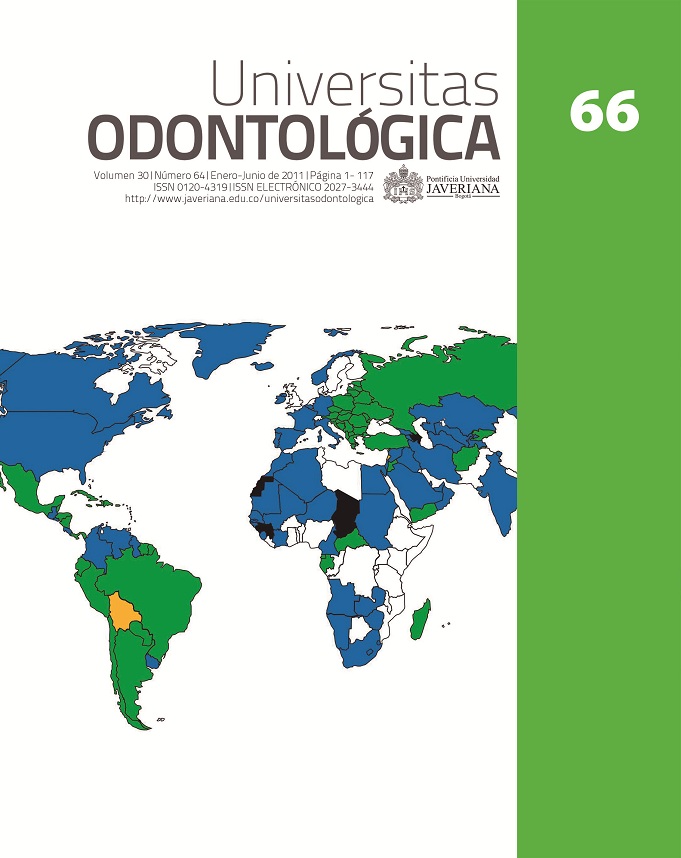Abstract
Antecedentes: la infección por virus herpes simple tipo 1 (VHS-1) es una de las más frecuentes en la población humana; produce infecciones en mucosa oral, piel, ojos e incluso en el sistema nervioso, que causa encefalitis. Después de la infección en la región orofacial, este virus puede permanecer en estado de latencia en el ganglio trigémino y eventualmente reactivarse. Objetivo: determinar la presencia de VHS-1 en ganglios trigeminales humanos mediante pruebas paralelas de PCR, RT-PCR e inmunohistoquímica. Métodos: previa aprobación del Comité de Ética de la Facultad de Odontología de la Universidad Nacional de Colombia y del Instituto de Medicina Legal y Ciencias Forenses, se recolectaron dieciséis pares de ganglios trigeminales humanos, que se procesaron tanto para extracción de ácidos nucleicos como para inmunohistoquímica. Resultados: en seis de los ocho donantes analizados por inmunohistoquímica se encontró marcaje positivo para antígeno de VHS-1. Se halló que nueve de los donantes evaluados por PCR para VHS-1 y cinco de los diez examinados para transcritos asociados a latencia (LAT) fueron positivos. Conclusión: se encontraron ganglios trigeminales en los que no se detectó virus y otros con distintos estados de infección (activa y latente). En casi todos los ganglios fue evidente el infiltrado inflamatorio asociado. El presente es el primer trabajo en el que se busca sistemáticamente tanto genoma viral como proteínas y transcritos LAT en ganglios trigeminales humanos, lo cual abre puertas para la investigación tanto de la epidemiología como de los fenómenos asociados a la LAT y reactivación del VHS-1.
Background: Infection by type 1 Herpes Simplex Virus (HSV-1) is the most frequent viral infection in human population being able to cause injuries in oral mucosa, skin, cornea, and even the central nervous system causing encephalitis. After mucosal infection, HSV-1 establishes a lifespan latent infection in trigeminal ganglia where it occasionally reactivates infecting primary sites again. It is little known about cell and molecular events responsible for infection reactivation and immune response in human ganglia. Objective: To standardize the obtaining and processing of human trigeminal ganglia to detect specific HSV antigen, DNA and RNA. Methods: After approval of the study by the Universidad Nacional IRB, 32 trigeminal ganglia were obtained from 16 cadavers from the Colombian Forensic Medicine Institute. Results: Using PCR technique to detect viral DNA, it was found that 56.3 % of ganglia (9/16) amplified specific fragment and five out of ten with suitable quality RNA were positive for latency associated transcript. Conclusion: Some trigeminal ganglia did not show evidence of infection and some had different HSV-1 infection status (active or latent) with inflammatory cells infiltrate in almost all samples. This is the first work that detects simultaneously genome, proteins and LAT of HSV-1 in human trigeminal ganglia, leading to explore findings about the latency and reactivation process.
This journal is registered under a Creative Commons Attribution 4.0 International Public License. Thus, this work may be reproduced, distributed, and publicly shared in digital format, as long as the names of the authors and Pontificia Universidad Javeriana are acknowledged. Others are allowed to quote, adapt, transform, auto-archive, republish, and create based on this material, for any purpose (even commercial ones), provided the authorship is duly acknowledged, a link to the original work is provided, and it is specified if changes have been made. Pontificia Universidad Javeriana does not hold the rights of published works and the authors are solely responsible for the contents of their works; they keep the moral, intellectual, privacy, and publicity rights.
Approving the intervention of the work (review, copy-editing, translation, layout) and the following outreach, are granted through an use license and not through an assignment of rights. This means the journal and Pontificia Universidad Javeriana cannot be held responsible for any ethical malpractice by the authors. As a consequence of the protection granted by the use license, the journal is not required to publish recantations or modify information already published, unless the errata stems from the editorial management process. Publishing contents in this journal does not generate royalties for contributors.


